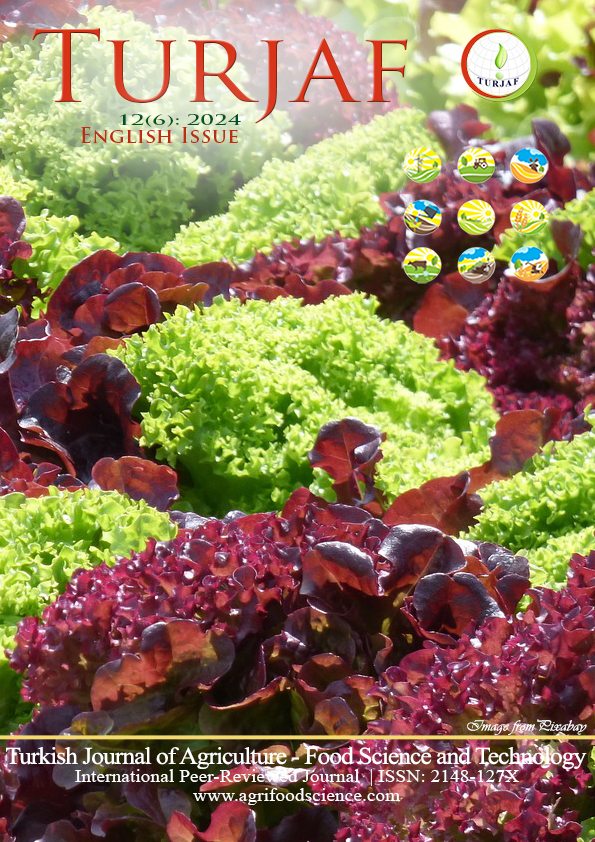Comparison of Chemical Constituents of Some Plant Species of Lamiaceae Family Grown Conventionally and Organically
DOI:
https://doi.org/10.24925/turjaf.v12i6.984-990.6750Keywords:
Organic Agriculture, Conventional Agriculture, Origanum onites., Salvia Officinalis, Lavandula OfficinalisAbstract
In this study, the chemical constituents of Origanum onites, Salvia officinalis and Lavandula officinalis plants belonging to Lamiaceae family grown by conventional and organic methods were determined by soxhlet extraction. Gas Chromatography-Mass Spectrometry (GC-MS) method was used to determine the chemical constituents of conventionally and organically grown plant samples. When the results of the analyses were examined, out of 97 chemical components of Salvia officinalis plant, 50 components were determined from plants grown with conventional farming methods and 78 components were determined from plants grown with organic farming methods. Of the 38 components detected in Origanum onites, 36 components were determined from plants grown with conventional farming methods and 38 components were determined from plants grown with organic farming methods. Out of 60 components of Lavandula officinalis, 40 components were determined from plants grown with conventional farming methods and 60 components were determined from plants grown with organic farming methods. In terms of chemical structure, the components are divided into different classes as hydrocarbons, monoterpenes, monoterpenoids, sesquiterpenes, sesquiterpenoids, diterpenes, diterpenoids, fatty acids and derivatives, and phenolic compounds.
References
Anonymous, (2021). Definition of Organic Agriculture. (https://www.fao.org/documents/card/en/c/cc3017en) (Erişim tarihi: 10.11.2023).
Baser, K. H. C., Özek, T., Kürkçüoglu, M., and Tümen, G. (1994). The Essential Oil of Origanum vulgare subsp. hirtum of Turkish Origin. Journal of Essential Oil Research, 6(1), 31–36. https://doi.org/10.1080/10412905.1994.9698321.
Baydar, H., Kineci, S., (2009). Scent composition of essential oil, concrete, absolute and hydrosol from lavandin (Lavandula x intermedia Emeric ex Loisel.). Journal of Essential Oil Bearing Plants, 12 (2): 131-136 https://doi.org/ 10.1080/0972060X.2009.10643702
Baytop, A. (1996). Farmasötik Botanik Ders Kitabı. İstanbul Üniversitesi Yayınları, 4, 3637. ISBN 9754042136, 9789754042139
Büyükkartal, H., Kahraman, A., Çölgeçen, H., Doğan, M. ve Karabacak, E. (2011). Mericarp micromorphology and anatomy of Salvia hedgeana Dönmez, S. huberi Hedge and S. rosifolia Sm.(section Salvia Hedge, Lamiaceae), Acta Botanica Croatica, 70, (1), 65-80. https://doi.org/10.2478/v10184-010-0011-8
Çetiner, S., & Tuzla, İ. (2005). Türkiye ve Dünyada Tarımsal Biyoteknoloji ve Gıda Güvencesi: Sorunlar ve Öneriler. GDO Bilgi Platformu, Sabancı Üniversitesi, İstanbul. https://www.inovasyon.gen.tr/images/makaleler/sizdenBize/S.Cetiner. Inovasyon.org.pdf
Davis, P. H. (Edt.) (1982). Flora of Türkiye and The East Aegean Islands, Vol. 7, Univ. Press, Edinburgh, 36-42, 297-313. ISBN: 9780852243961
Gonçalves, S., Serra, H., Nogueira, J. M. F., Almeida, R., Custódio, L., Romano, A., (2008). Headspace-SPME of in vitro shoot-cultures and micropropagated plants of Lavandula viridis. Biologia plantarum, 52, 133-136. https://doi.org/10.1007/s10535-008-0027-2
Guenther, E. 1952. The essential oils, R.E. Krieger Pub. Co. 5: 3-38. ISBN 0882750739 (v. 1)
Kara, N., (2011). Uçucu yağ üretimine uygun lavanta (Lavandula sp.) çeşitlerinin belirlenmesi ve mikroçoğaltım olanaklarının araştırılması, [Doktora tez çalışması. SDÜ Fen Bilimleri Enstitüsü, Süleyman Demirel Üniversitesi]. Isparta, Türkiye.
Marquardt G., (1987). Proton Transporting Enzymes at the Tonoplast of Leaf Cells of the CAM Plant Kalanchoë daigremontiana. II. The Pyrophosphatase. Journal of Plant Physiology. Journal of Plant Physiology.129, 269-286 https://doi.org/10.1016/S0176-1617(87)80085-8
Mot, M.-D.; Gavrilas, , S.; Lupitu, A.I.; Moisa, C.; Chambre, D.; Tit, D.M.; Bogdan, M.A.; Bodescu, A.-M.; Copolovici, L.; Copolovici, D.M.; et al. (2022). Salvia officinalis L. Essential Oil: Characterization, Antioxidant Properties, and the Effects of Aromatherapy in Adult Patients. Antioxidants, 11, 808. https://doi.org/10.3390/antiox11050808
Moussii, I. M., K. Nayme, M. Timinouni, J. Jamaleddine, H. Filali, and F. Hakkou. (2020). Synergistic antibacterial effects of Moroccan Artemisia herba alba, Lavandula angustifolia Mill. and Rosmarinus officinalis L. essential oils. Synergy 10: 1-7. https://doi.org/10.1590/S1519-69842011000100018
Official methods and recommended practices (1993) The American Oil Chemists Society. In: Firestone D (ed), Champaign, IL: AOCS.
Özler, H., Pehlivan, S., Kahraman, A., Dogan, M., Celep, F., & Bagherpour, S. (2011). Pollen morphology of the genus Salvia L. (Lamiaceae) in Türkiye. Flora 206, 316–327. https://doi.org/10.1016/j.flora.2010.07.005
Rai, V. K., P. Sinha, K. S. Yadav, A. Shukla, A. Saxena, D. U. Bawankule, S. Tandon, F. Khan, C. S. Chanotiya, and N. P. Yadav. 2020. Anti-psoriatic effect of Lavandula angustifolia Mill. essential oil and its major components linalool and linalyl acetate. Journal of Ethnopharmacology 261. https://doi.org/10.1016/j.jep.2020.113127
Sarker, L.S., Galata, M., Demissie, Z.A. ve Mahmoud, S.S. (2012). Molecular Cloning and Functional Characterization of Borneol Dehydrogenase from the Glandular Trichomes of Lavandula x intermedia. Archives of Biochemistry and Biophysics. 528:163–170. https://doi.org/10.1016/j.abb.2012.09.013
Sharifi-Rad, M. et al. (2018). Salvia spp. plants-From Farm to Food applications and Phytopharmacotherapy. Trends in Food Science & Technology. S0924- 2244(18)30115-8. https://doi.org/10.1016/j.tifs.2018.08.008
Sönmez, İ., Kaplan, M., Sönmez, S. (2008). Kimyasal gübrelerin çevre kirliliği üzerine etkileri ve çözüm önerileri. Batı Akdeniz Tarımsal Araştırma Enstitüsü Derim Dergisi. 25(2), 24-34. ISSN 1300-3496
Stahl-Biskup E (2002). Thyme as a herbal drugpharmacopoeias and other product characteristics, in Stahl-Biskup and Saez (eds). The genus Thymus, Taylor & Francis, London. 293. https://doi.org/10.4324/9780203216859
Tohidi, B., Rahimmalek, M., Arzani, A.(2017). Essential oil composition, total phenolic, flavonoid contents, and antioxidant activity of Thymus species collected from different regions of Iran. Food Chemistry, 220: 153-161 https://doi.org/10.1016/j.foodchem.2016.09.203
Topbaş, M. T, Brohi, A. R., & Karaman, M. R. (1998). Çevre Kirliliği. T.C. Çevre Bakanlığı Çevre Bakanlığı Yayını. Ankara. 340 s. OCLC Number / Unique Identifier: 283726090
Topçu, G., (2006). “Bioactive Triterpenoids from Salvia Species”, Journal of natural products, 69, (3), 482-487, https://doi.org/10.1021/np0600402
Unicef 2021. The State of Food Security and Nutrition in the World (2021). https://data. unicef.org/resources/sofi2021/ (Alınma tarihi: 30.01.2023)
Urwin, N., (2009). Improvement of Lavender Varieties by Manipulation of Chromosome Number. Rural Industries Research and Development Corporation. ISBN 1741517893
Vessey, J. K. (2003). Plant growth promoting rhizobacteria as biofertilizers. Plant and Soil. 255, 571–586. https://doi.org/10.1023/A:1026037216893
Yılmaz, G. ve Güvenç, A. (2007). Ankarada aktarlarda “Adaçayı” adı altında satılan drogların morfolojik ve anatomik olarak incelenmesi, Ankara Eczacılık Fakültesi Dergisi. 36, (2), 87-104. https://dergipark.org.tr/tr/download/article-file/424431
Zengin, M., (2007). Organik Tarım. Hasad Yayıncılık, İstanbul, 136 s. ISBN 9758377531,9789758377534
Downloads
Published
How to Cite
Issue
Section
License
This work is licensed under a Creative Commons Attribution-NonCommercial 4.0 International License.









